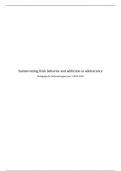Summary
Samenvatting Risk Behavior and Addiction in Adolescence
- Course
- Institution
Dit is een samenvatting van alle stof voor het tentamen. Het bevat alle verplichte artikelen en aantekeningen van de hoorcolleges van studiejaar 2024/2025.
[Show more]




